 Do school vouchers save the taxpayer money, or do they add to taxpayer burdens? Which groups of taxpayers are most affected, and do they gain or lose? What is the financial impact on public school districts? Usually, these questions are debated in the abstract. Now it is possible to get more concrete answers from the nation’s longest-running school voucher initiative, the Milwaukee Parental Choice Program (MPCP) in Wisconsin.
Do school vouchers save the taxpayer money, or do they add to taxpayer burdens? Which groups of taxpayers are most affected, and do they gain or lose? What is the financial impact on public school districts? Usually, these questions are debated in the abstract. Now it is possible to get more concrete answers from the nation’s longest-running school voucher initiative, the Milwaukee Parental Choice Program (MPCP) in Wisconsin.
The fiscal impact of that program has been a matter of dispute. According to school choice supporters, such as Marquette University professor and former Milwaukee Public Schools (MPS) superintendent Howard Fuller, MPCP saves the taxpayers considerable cash, as the voucher is smaller than per-pupil spending by MPS. But Wisconsin state senator Russ Decker, a leading opponent of vouchers, has argued that the program gives money to children who would attend private schools anyway and declared, “You’ve got a lot of additional money going into the choice program that we could better use funding public education statewide.” Wisconsin’s Legislative Fiscal Bureau, which conducts budget-related analyses for state legislators, has provided fodder to both sides of the Milwaukee voucher debate with periodic estimates of the financial impact of eliminating the program based on a wide range of assumptions regarding changes in public schoolenrollments.
The dollar amounts in question have become significant, as the voucher program continues to grow. MPCP started in fiscal year 1991 as a small initiative, capped at 1 percent of MPS enrollment, with a few hundred students from low-income families who chose to attend secular private schools. (In the remainder of this paper, “fiscal year” shall be generally understood.) Starting in 1999, the state expanded the program to religious schools and lifted the cap to 15 percent of MPS enrollment (about 15,000 students). In 2007 the cap was raised to 22,500. With these changes in the legal framework, enrollments have grown steadily to about 18,500 students in 2008 (see Figure 1).
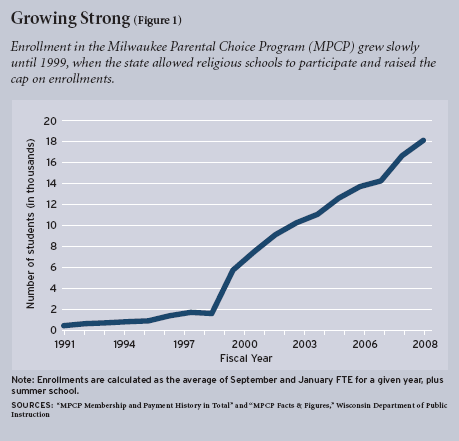 The way in which the legislature funds the program has also changed in important ways over the years. Fiscal impacts have varied over time as a result of those decisions. At the same time, features that were adopted when the program was small outlived their rationale as the program grew, and the vestiges that persisted have caused notable distortions.
The way in which the legislature funds the program has also changed in important ways over the years. Fiscal impacts have varied over time as a result of those decisions. At the same time, features that were adopted when the program was small outlived their rationale as the program grew, and the vestiges that persisted have caused notable distortions.
What has been the net fiscal impact of MPCP? Who has benefited and who has taken a hit as the program has grown? How has MPCP affected taxpayers statewide? Milwaukee taxpayers? In this analysis, I show that under most plausible scenarios the program has saved taxpayers money annually since 2000, with estimated savings reaching $31.9 million in 2008. The beneficiaries have been Wisconsin state taxpayers and property taxpayers outside of Milwaukee. Property taxpayers in Milwaukee, however, have seen their taxes go up, the result of legislative decisions on the MPCP funding formula made in the program’s earliest days.
Designing a Voucher Program
It is important to recognize that any fiscal impact of MPCP on school districts and taxpayers is not inherent in the concept of a voucher, but the result of specific characteristics of the situation in Wisconsin. As a benchmark case, consider a hypothetical voucher program that has no net impact on taxpayers or on per-pupil district revenues. First, suppose all voucher students would otherwise have gone to a public school. Second, suppose the amount of the voucher is identical to the revenues per pupil at the district school. The diversion of voucher funds from the district to the voucher school would leave per-pupil revenues unchanged and would also have no net impact on taxpayers. The money simply follows the child in the same way that state monies follow children when they move from one school district to another that has equal per-pupil revenues.
In one important respect, today’s MPCP matches the hypothetical program. Although this was not initially the case, since 2000 the formulas that determine state and local revenues for MPS have not counted voucher students. Because the revenues MPS is allowed to spend are calculated on a per-pupil basis, the loss of a voucher student leaves MPS per-pupil revenues unaffected, as is the case when a student leaves for another district.
The impact on the public purse is a different matter. The amount of the voucher is less than the per-pupil revenues allocated to MPS, which implies a savings for taxpayers, just as voucher supporters claim.
Offsetting such savings, however, are the voucher expenses for those eligible students who, in the absence of the program, would still have attended a private school. Those families would have saved the taxpayer money by paying their own education bill, but as they are eligible for a voucher, they can attend the private school at public expense instead. The taxpayer bears the cost that the low-income family would otherwise have borne. One might well argue that this is a worthy use of taxpayer funds, but in the narrow context of determining the program’s fiscal effects, it counts as a negative impact.
The net impact on taxpayers, then, is 1) the savings that come from the difference between the voucher and the per-pupil revenue at district schools, for those who would have attended them in the absence of the voucher program, minus 2) the voucher costs for students who would have attended private schools anyway. Let’s consider the latter factor first.
Estimating Private School Use
According to a federal survey, about 5 percent of low-income families send their children to private school, less than half the 12 percent rate for all families. That figure may underestimate what we are looking for, which is the percentage of low-income voucher users who would have attended private schools without them. One can derive a better estimate from recent research conducted on other urban voucher programs that serve low-income families. Those studies have collected information on private school usage by voucher-seeking families, both those who were awarded vouchers (by lottery) and those who were not. Only a few thousand such students have been studied, so estimates are not from as large a sample as one would like, and the cities in these studies may differ from Milwaukee in some respects, but the data provide as direct an estimate as can be obtained. A midrange estimate derived from this literature is that about 10 percent of voucher-using students from low-income families in big cities would have attended private schools anyway (the percentage is higher for one-year attendance and lower for more sustained attendance).
This 10 percent estimate can be checked for consistency with trends in private school enrollment before the voucher program began in Milwaukee. I have examined long-term trends for private school enrollment using two data sets. University of Wisconsin professor John Witte reports on Milwaukee private school enrollments from 1960 to 1997, while the Wisconsin Department of Public Instruction (DPI) provides enrollment figures for Milwaukee’s private schools from 1993 to 2008.
These data show a drop of more than 25,000 in private school enrollment from the mid-1960s to the beginning of MPCP (interrupted by a temporary rise from 1977 to 1984). The Catholic schools were particularly hard hit, having served an ethnic population that was migrating to the suburbs throughout these decades.
I have spliced the two data sets together for the period since MPCP began and examined the trends that would have obtained without the program, under varying assumptions about the percentage of voucher students that would have attended private schools anyway. I find that under the 10 percent estimate drawn from the lottery literature, the resulting private enrollments are consistent with prior trends. When it is assumed that 30 percent of voucher-using families would have chosen private schools, the resulting enrollments imply a noticeable slowdown of the long-term downward trends, a result that seems possible, but not at all compelling. If the rate were assumed to be 50 percent or more, long-term downward trends would have been reversed, which does not seem credible.
To summarize, data from voucher experiments in other cities indicate that about 10 percent of low-income voucher users would have attended private school anyway. This estimate is consistent with long-term downward trends in Milwaukee private enrollments, while rates of 30 percent or higher are not consistent with those trends. I provide estimates below of the fiscal impact of MPCP under assumptions ranging up to 30 percent, but 10 percent is probably closer to the correct figure.
Measuring the Gap
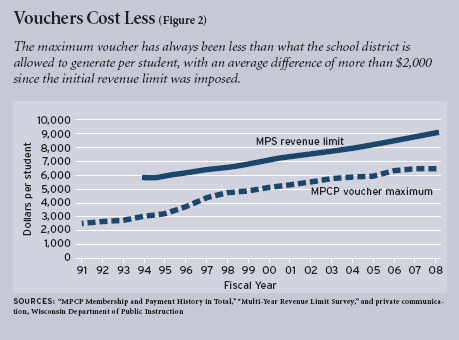 The other factor needed to calculate MPCP’s net fiscal impact is the gap between the voucher and MPS per-pupil revenues. The specific concept I use for MPS is the “revenue limit,” set by Wisconsin statute, which places a maximum on each district’s combined revenues from local property taxes and state formula aid. Although districts are not required to raise local levies up to the amount allowed by the revenue limit, in practice, that is what happens: statewide, approximately 99.8 percent of revenue limit capacity is used and, in most recent years, Milwaukee has used 100 percent. The revenue limit does not cover federal revenues, but this can be ignored when estimating the impact of MPCP on state and local taxpayers. Nor does it include categorical state aid, primarily for special education and low-income students, which constitutes about 6 percent of revenues from state aid and property taxes in Wisconsin, and 9 percent in Milwaukee. This means my analysis will underestimate the savings from voucher students, since some of them would draw on categorical state aid were they in MPS.
The other factor needed to calculate MPCP’s net fiscal impact is the gap between the voucher and MPS per-pupil revenues. The specific concept I use for MPS is the “revenue limit,” set by Wisconsin statute, which places a maximum on each district’s combined revenues from local property taxes and state formula aid. Although districts are not required to raise local levies up to the amount allowed by the revenue limit, in practice, that is what happens: statewide, approximately 99.8 percent of revenue limit capacity is used and, in most recent years, Milwaukee has used 100 percent. The revenue limit does not cover federal revenues, but this can be ignored when estimating the impact of MPCP on state and local taxpayers. Nor does it include categorical state aid, primarily for special education and low-income students, which constitutes about 6 percent of revenues from state aid and property taxes in Wisconsin, and 9 percent in Milwaukee. This means my analysis will underestimate the savings from voucher students, since some of them would draw on categorical state aid were they in MPS.
Figure 2 depicts the per-pupil revenue limit for MPS, which rose from $5,804 in 1994 (the year Wisconsin established revenue limits) to $9,141 in 2008. The graph also depicts the increase in the maximum MPCP voucher, from $2,446 in 1991 to $6,501 in both 2007 and 2008. (The average voucher is slightly less than the maximum. Since average voucher data are only available with a lag, I use the maximum voucher in this analysis, which slightly underestimates the savings from MPCP.) The gap between the MPS revenue limit and the MPCP maximum voucher size was generally around $2,000 from 1997 to 2003, but drifted up to $2,332 in 2007 and $2,640 in 2008.
Net Fiscal Impact
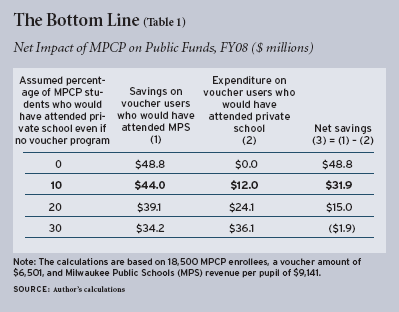 MPCP’s impact on taxpayers can be readily calculated from the gap between the voucher and per-pupil MPS revenues, under any given assumption regarding the percentage of voucher users who would have otherwise attended private school. Table 1 presents these calculations for 2008, with each row representing a different assumption, from 0 to 30 percent. My preferred estimate, as explained above, is 10 percent, indicated by the bold figures, and the other rows show how the results vary depending on the assumption one makes about private school usage in the absence of vouchers.
MPCP’s impact on taxpayers can be readily calculated from the gap between the voucher and per-pupil MPS revenues, under any given assumption regarding the percentage of voucher users who would have otherwise attended private school. Table 1 presents these calculations for 2008, with each row representing a different assumption, from 0 to 30 percent. My preferred estimate, as explained above, is 10 percent, indicated by the bold figures, and the other rows show how the results vary depending on the assumption one makes about private school usage in the absence of vouchers.
The calculations are based on 18,500 enrollees in MPCP, a voucher amount of $6,501, and MPS revenue limit per pupil of $9,141. Consider the results under the 10 percent assumption, shown in the second row. Column 1 shows the savings on voucher users who would have attended MPS. At the 10 percent rate, there are 16,650 such students (0.90 ¥ 18,500), each of whom saves $2,640 in public funds ($9,141 – $6,501), for a total of $44 million. Column 2 shows the expenditure on voucher users who would have attended private schools anyway. At the 10 percent rate, 1,850 such students each receives $6,501, for a total of $12 million. Column 3 shows the net savings, the difference between columns 1 and 2, which is $31.9 million.
As the other rows show, the result is somewhat sensitive to the assumed percentage, but for most of the relevant range the net savings amount is positive. It does not turn negative unless one assumes close to 30 percent of MPCP’s low-income voucher users would have attended private schools, an assumption that seems unrealistically high.
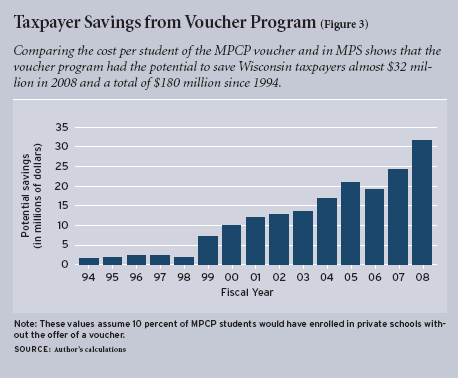
Figure 3 depicts the net fiscal benefit from MPCP from 1994 to 2008, assuming that 10 percent of voucher users would have attended private schools. The net benefit was only about $2 million per year prior to the program’s expansion in 1999. Since then, as MPCP enrollments have grown and as the gap has widened between the voucher and MPS revenues per pupil, the benefit has grown from $7.3 million to $31.9 million in 2008. The remainder of my analysis addresses the questions of which taxpayers benefited, how the distribution of benefits has evolved over the life of the program, and why.
Wisconsin School-Funding Formulas
To understand the distribution of MPCP’s fiscal impact, one needs first to learn about Wisconsin’s regular school-funding formulas. There are two interlocked formulas: revenue limits and equalization aid. The revenue limit formula, underlying Figure 2, takes each district’s per-pupil revenues from the prior year and tacks on a legislatively determined annual increment. The total revenue each district is allowed to raise from property taxes and general state aid is simply that per-pupil amount, multiplied by enrollment (smoothed by three-year averaging).
The equalization aid formula determines the split of each district’s total revenue between state aid and local property taxes, with differences across districts based primarily on per-pupil property values. Taken as a whole, Wisconsin state aid has generally comprised two-thirds of the school revenues statewide, leaving one-third to be raised from property taxes, an arrangement that was once codified in state law and more recently persists by political custom.
Together, the two formulas determine the distribution of any cost savings that result from enrollment shifts. Suppose, for example, a number of students leave Milwaukee for a lower-spending rural district. Total revenues fall for MPS and rise for the rural district, but by a lesser amount, for a net saving of public funds. Two-thirds of the savings accrue to state taxpayers. The other third accrues to local property taxpayers across the state. This property tax relief is distributed across the state in approximate proportion to local property values. Specifically, Milwaukee property taxpayers would receive about 6 percent of the statewide property tax relief, since that is Milwaukee’s approximate share of statewide property values.
In principle, the funding for the voucher program could be integrated into the regular funding system. There is, after all, no inherent fiscal difference between students leaving MPS with lower-cost vouchers and students leaving for lower-cost districts. As public funds are freed up by voucher-using students, the net savings could be distributed among state taxpayers and property taxpayers across the state through these formulas. As we shall see, however, a rather different funding mechanism was adopted for MPCP.
Before 2000
In the earliest days of MPCP, when the program was very small, the funding formula had three key features. First, voucher students were counted as part of MPS enrollments for the purposes of calculating revenue limits and equalization aid. Second, the voucher expenses were deducted from MPS’s equalization aid. Finally, Milwaukee was given the option of raising its property taxes beyond that allowed by the ordinary revenue limit, to make up for the voucher expenses deducted from its state aid.
This was not an unreasonable system, for both economic and political reasons, in the earliest days of the program. For one thing, it effectively insulated the state budget and property taxes outside of Milwaukee from the program. In addition, the nature of the impact was left up to Milwaukee: it could choose to let the voucher money follow the child, accepting a net reduction in total (but not per-pupil) MPS revenues. Or, it could choose to maintain total MPS revenues, by paying for the vouchers out of higher property taxes.
Milwaukee chose the latter option, for reasons that are perhaps understandable. It might be argued, for example, that the decline in MPS enrollment was too small to affect certain indivisible costs, such as the number of teachers or buildings that comprise the lion’s share of the district’s budget. In this view, it would be justified to maintain total revenues, despite falling enrollments, for a higher revenue per pupil. In any case, the initial magnitudes were not huge: the impact on Milwaukee property taxes was no more than $2.5 million by 1995 and $7 million by 1998. This impact is depicted in Figure 4 by the dark bars in the negative region. The dotted bars in the positive region for this period represent the impact on MPS of the rise in per-pupil revenues.
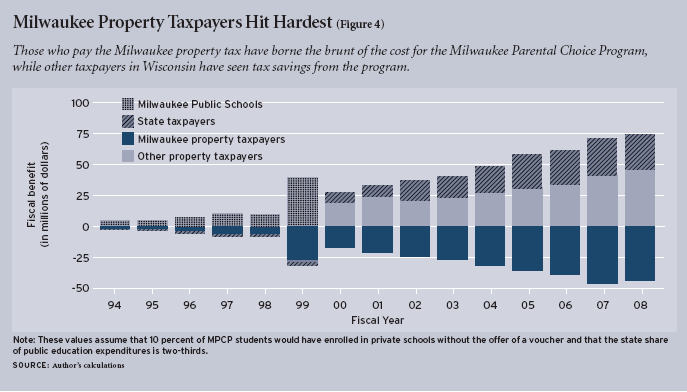
With the program’s expansion to religious schools in 1999—MPCP enrollment nearly quadrupled that year—the impact on Milwaukee property taxes jumped to $28.3 million, as shown in Figure 4. The fixed-cost rationale for maintaining MPS total revenues became more tenuous, as MPCP enrollments approached 6,000, larger than 95 percent of all school districts in Wisconsin. But MPS chose to maintain total revenues, collecting $39.5 million more than would have been needed to maintain the per-pupil amount. The program had clearly outgrown its initial fiscal formula.
Reform Incomplete
Starting in 2000, voucher students were no longer included in the calculation of MPS revenue limits or equalization aid. This was a major reform. As a result, MPS was no longer able to maintain total revenues as it lost MPCP students, but could still maintain per-pupil revenues. Consequently, the dotted bars in Figure 4 disappear starting in 2000. The savings from MPCP were now fully available for taxpayer relief.
But the reforms were not complete. Logically, as the revenue limit of MPS fell with the departure of MPCP students, money that was freed up in the state’s general fund could have directly funded the vouchers. Funding would have followed the child, much as it does between school districts under the regular funding formulas.
Instead, the funding formula continued to deduct voucher expenses from MPS equalization aid, although the deduction was cut in half. Specifically, starting in 2000, half the voucher deduction was moved from the equalization aid of MPS to the other districts of the state. Later, the draw on other districts’ aid was eliminated, replaced by a direct draw on the general fund, and the aid deduction for MPS was reduced from 50 to 45 percent of voucher expenses. The key point here is that MPS still loses state aid to cover almost half the voucher expenses, even though MPS no longer receives any aid for MPCP students. This means MPS stands to lose revenues on a per-pupil basis.
To avoid this result, Milwaukee is still allowed to offset the MPCP deduction by raising property taxes—and it has chosen to do so. The resulting impact on Milwaukee property taxes can be seen in the dark bars in Figure 4. Starting in 2000, the impact is approximately halved from what the previous system implied, but the rationale for any adverse impact is gone. These higher property taxes no longer pay for the option of maintaining total revenues as enrollments decline; instead, they are necessary to maintain per-pupil revenues.
This means the entire net benefits of the MPCP program (and more) now accrue to state taxpayers and property taxpayers outside of Milwaukee, as depicted in the striped and light bars in Figure 4.
Fiscal Impact 2008
To understand the mechanics reflected in Figure 4, consider the data for 2008. Milwaukee property taxes were raised to defray voucher expenses totaling $54.1 million (0.45 ¥ $6,501 for each of 18,500 MPCP students). This was slightly offset by Milwaukee’s $3.1 million share of statewide property tax relief (discussed below), but still reached $51 million. Faced with the growing impact, the governor and the city of Milwaukee pressed for reform. The legislature responded with an ad hoc measure, “high poverty aid,” to reduce school property taxes, primarily in Milwaukee. This amounted to $7.4 million in 2008, so the adverse impact on Milwaukee property taxpayers was reduced from $51 million to $43.6 million.
Meanwhile, the rest of the state continued to benefit from MPCP. Because the 18,500 voucher users do not count in MPS revenue limits, $9,141 each was saved for the 90 percent of voucher students we assume would have attended MPS, a total of $152.2 million. Of that, one-third, or $50.7 million, went to statewide property tax relief. Milwaukee’s share was approximately $3.1 million (proportional to their share of statewide property values), leaving $47.6 million as the net benefit to property taxpayers outside of Milwaukee, depicted by the light bar in Figure 4.
The state’s general fund gained the other two-thirds of the $152.2 million saved from MPS revenue limits, or $101.5 million. However, the general fund paid 55 percent of the voucher expenses, totaling $66.1 million (0.55 ¥ $6,501 for each of 18,500 MPCP students). In addition, for 2008, the ad hoc property tax relief for Milwaukee cost $7.4 million. So the net benefit to state taxpayers was $101.5 million minus $66.1 million minus $7.4 million, which equals $27.9 million, depicted by the striped bar in Figure 4.
Drawing these all together, we have $27.9 million (state benefit) plus $47.6 million (non-Milwaukee property tax relief) minus $43.6 million (adverse impact on Milwaukee), which equals a $31.9 million net impact. This is the figure shown in Table 1. This net savings of $31.9 million from MPCP accrued entirely to the state’s taxpayers and property taxpayers outside of Milwaukee, along with an additional windfall of $43.6 million, effectively paid by the property taxpayers of Milwaukee.
Conclusion
The history of the MPCP illustrates how voucher programs can provide significant taxpayer savings when students voluntarily choose to attend schools that draw less on public funds than the schools they would otherwise attend. However, the same history also illustrates that if the funding formulas are not carefully constructed—and reformed as growth requires—some groups of taxpayers may be adversely affected.
The initial funding mechanism was designed for a small program, so the district was allowed to maintain total expenditures as enrollments dipped, through modest increases in property taxes. As the program grew, the mechanism was modified to enable the district to maintain per-pupil revenues, rather than total revenues. However, vestiges of the original funding mechanism meant that Milwaukee property taxes had to go up just to maintain per-pupil revenues. The underlying reason is that instead of funding the vouchers out of the savings to the state’s general fund, 45 percent of voucher expenditures are still deducted from Milwaukee’s state aid, even though their aid has not included funds for voucher students since 2000.
So who gains? State taxpayers and property taxpayers outside of Milwaukee. Who loses? Milwaukee property taxpayers. And why? We have seen the mechanics of how this occurred, but ultimately, this is a political question. The policymakers of Milwaukee and Wisconsin have known for some time about MPCP’s “funding flaw” (as it is called). It remains to be seen whether, as the program grows, this flaw will undermine it or instead lead legislators to complete the reforms that would integrate MPCP with the regular funding formulas so the benefits can be shared by all.
Robert M. Costrell is professor of education reform and economics at the University of Arkansas. The report from which this paper is drawn is part of the comprehensive evaluation of the Milwaukee Parental Choice Program being conducted by the School Choice Demonstration Project at the University of Arkansas.


